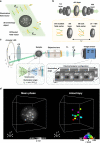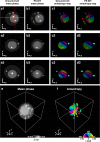Polarization-sensitive intensity diffraction tomography
- PMID: 37202421
- PMCID: PMC10195819
- DOI: 10.1038/s41377-023-01151-0
Polarization-sensitive intensity diffraction tomography
Abstract
Optical anisotropy, which is an intrinsic property of many materials, originates from the structural arrangement of molecular structures, and to date, various polarization-sensitive imaging (PSI) methods have been developed to investigate the nature of anisotropic materials. In particular, the recently developed tomographic PSI technologies enable the investigation of anisotropic materials through volumetric mappings of the anisotropy distribution of these materials. However, these reported methods mostly operate on a single scattering model, and are thus not suitable for three-dimensional (3D) PSI imaging of multiple scattering samples. Here, we present a novel reference-free 3D polarization-sensitive computational imaging technique-polarization-sensitive intensity diffraction tomography (PS-IDT)-that enables the reconstruction of 3D anisotropy distribution of both weakly and multiple scattering specimens from multiple intensity-only measurements. A 3D anisotropic object is illuminated by circularly polarized plane waves at various illumination angles to encode the isotropic and anisotropic structural information into 2D intensity information. These information are then recorded separately through two orthogonal analyzer states, and a 3D Jones matrix is iteratively reconstructed based on the vectorial multi-slice beam propagation model and gradient descent method. We demonstrate the 3D anisotropy imaging capabilities of PS-IDT by presenting 3D anisotropy maps of various samples, including potato starch granules and tardigrade.
© 2023. The Author(s).
Conflict of interest statement
The authors declare no competing interests.
Figures




References
LinkOut - more resources
Full Text Sources

